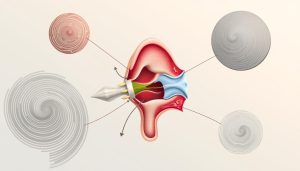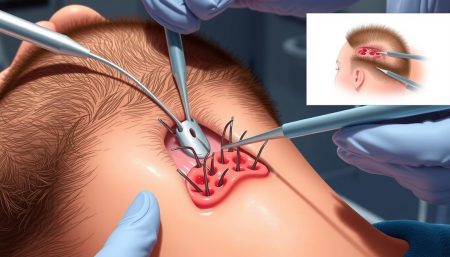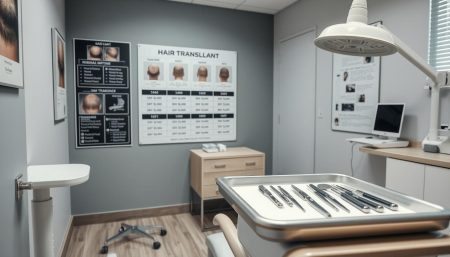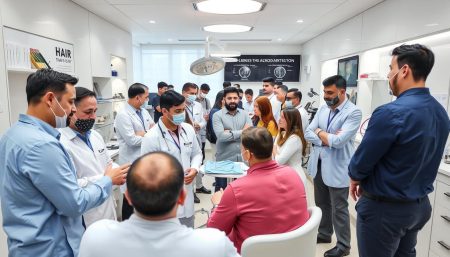In the quest for a youthful look and fighting hair loss, traditional hair transplant techniques have been a beacon of hope. This mix of old and new practices takes us into the world of hair restoration procedure. It shows the progress from the start of surgical hair transplantation to today’s advanced methods.
Learning about these early days is more than just history. It’s a way to honor those who fought to regain their confidence and look through old solutions.
Their tales of courage and hope are inspiring. They show the bravery needed to try early hair restoration methods, facing the unknown with a wish for change. Let’s explore the history of hair restoration together. It’s a story of experience and hope shaping the field of surgical hair solutions.
The Evolution of Hair Transplant Surgery
Hair replacement surgery has seen big changes over time. It has moved from simple methods to advanced ones that look more natural. This shows how hair loss treatment has improved, helping more people find solutions.
The Beginnings of Hair Restoration Procedures
At first, hair transplant surgeries were very invasive. They used big grafts, leading to a “pluggy” look. These early methods were the only hope for those with a lot of hair loss, but they had big limits in looks.
How Technology Has Changed Hair Transplantation
Now, technology has changed hair replacement surgery a lot. New, less invasive methods like Follicular Unit Extraction (FUE) and robotics make it more precise. These changes mean less scarring and quicker healing, making it easier for patients.
These new technologies have made hair transplant surgery better in many ways. They’ve improved how efficient and natural it looks, and made patients happier. This shows a big push to make cosmetic procedures better and care for patients more.
Distinguishing Traditional Hair Transplant Techniques
In the world of hair restoration, some old methods stand out. These outdated hair transplant methods, known as ‘hair transplant surgery old style’, were once new but now seem old-fashioned. They are less effective than today’s advanced techniques.
Old hair transplant methods mainly used mini-grafting and slit grafting. These methods took a big piece of hair-bearing scalp and cut it into smaller parts. Then, they were moved to bald spots. These old ways were more invasive, left big scars, and took longer to heal.
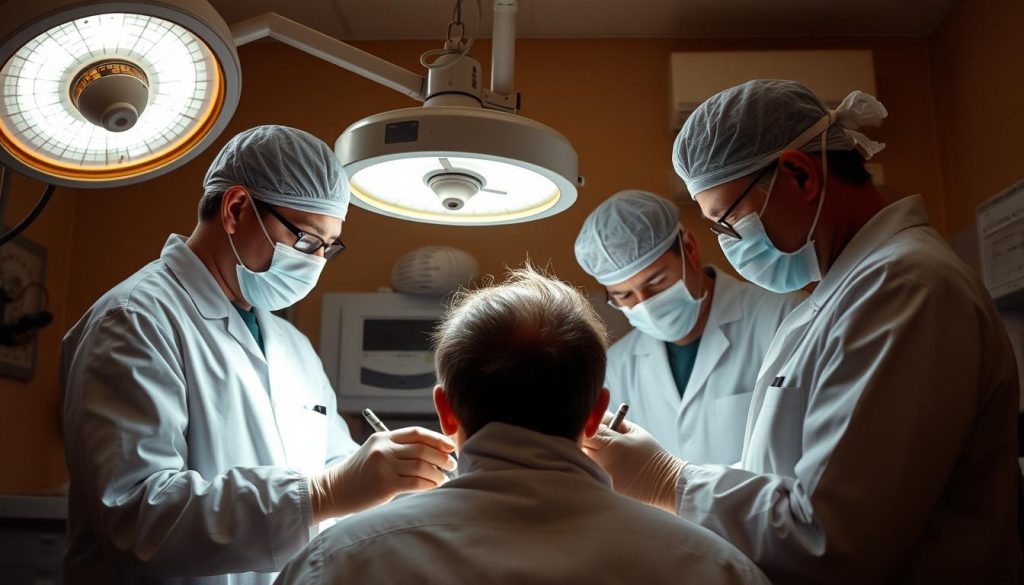
- The use of larger grafts which could lead to an unnatural look, often referred to as the “pluggy” appearance.
- Higher likelihood of scarring and longer healing times.
- Less precision in hair placement, making it difficult to achieve a natural hairline.
These outdated hair transplant methods are no longer popular because of new technology. Modern methods like Follicular Unit Extraction (FUE) and Follicular Unit Transplantation (FUT) are more precise. They give better results and less scarring.
| Old Style Hair Transplant | Modern Techniques | |
|---|---|---|
| Method | Mini-grafting, punch grafts | Follicular Unit Extraction (FUE) |
| Appearance | Can appear ‘pluggy’, less natural | Seamless, natural-looking |
| Recovery Time | Extended healing, more discomfort | Reduced downtime, minimal discomfort |
| Scarring | More visible scars | Minimal to no scarring |
Knowing the differences is key for those thinking about hair restoration. While old methods might seem cheaper, modern techniques offer better looks and comfort. The benefits of new methods are clear.
hair transplant surgery old style
Looking back at old hair restoration methods shows a journey of innovation. The early days used punch grafts, mini/micrografting, and scalp reductions. These steps laid the foundation for today’s hair transplant techniques.
Defining the Old Style Approach
Old hair transplant methods used big grafts and invasive techniques. These were common before new tech came along. They were simple but have evolved with better medical tools and beauty knowledge.
Typical Procedures and Methodologies
Punch grafts were the first, using a circular blade to move hair from one spot to another. Later, mini/micrografting made grafts smaller for a less obvious look.
Scalp reduction was another method, cutting away bald skin to stretch the hair area. It worked but didn’t always look or feel great.
These early methods led to today’s hair transplants. They showed the importance of caring for patients in cosmetic surgery. Moving from these old ways to today’s techniques shows big progress in how we do hair transplants.
Understanding Follicular Unit Transplantation
Follicular Unit Transplantation (FUT) is a well-known hair restoration method. It involves taking a strip of tissue from the back of the head. This area has denser hair and is less prone to balding.
The strip is then carefully cut into individual follicular units. Each unit has 1 to 4 hairs. These units are then moved to the balding areas. This method is great for hair grafting because it allows for many grafts in one session.
What Is Follicular Unit Transplantation (FUT)?
FUT is a surgical method that takes hair in groups of 1 to 4 hairs. These groups also have oil glands, nerves, a small muscle, and fine vellus hairs. Transplanting these groups makes the hair look more natural than older methods.
Pros and Cons of FUT
- Pros:
- It’s efficient in transplanting many hairs at once.
- It’s cost-effective compared to other methods.
- The hair grafts have a high survival rate.
- Cons:
- It leaves a linear scar in the donor area, which can be a concern for those with short hair.
- The recovery time is longer than less invasive methods.
- There can be pain and discomfort in the donor area after surgery.
Choosing FUT depends on your hair loss, lifestyle, and personal preferences. Knowing these factors helps in deciding between FUT and other hair grafting methods.
FUT has led to improvements in hair restoration. It allows for natural-looking hairline and density restoration. Despite its challenges, many see it as a good option for significant hair loss.
Examining the Outcomes of Old Style Transplant Methods
Looking into hair transplant surgery old style effectiveness shows us both the good and the bad. We see how these old ways have shaped today’s hair transplant methods. This journey helps us understand how far we’ve come.
Back then, hair transplants were done with punch grafts. These were basic and didn’t always work well. People had big scars and took longer to heal, unlike today’s methods.
- Visibility of Scars: Old hair transplant methods left big scars. This was because the grafts were large, making scars obvious.
- Density and Natural Appearance: It was hard to get a natural look with old methods. The size and placement of grafts didn’t always match the natural hairline.
- Success Rate: The success of old hair transplant surgery varied. It depended on the surgeon’s skill and the technology back then.
People who got hair transplants back then had mixed feelings. Some were happy to have more hair. But others were unhappy with the look or the long recovery time.
Now, we have better techniques. We can place grafts more precisely and use smaller ones. This leads to better looks and faster healing.
Looking at old hair transplant methods teaches us a lot. It shows us how important new technology and techniques are. They make hair transplants better today.
Surgical Hair Transplantation: The Patient’s Journey
Starting a hair loss treatment journey is a big step towards getting back your hair and confidence. Hair transplantation surgery has two main parts: hair transplant surgery preparation and recovery. Each part is designed to help you get the best results. This part will cover what you can expect from the first meeting to after the surgery.
Consultation and Planning
Before any surgery, detailed talks set the stage for a successful change. Here, people talk about their goals and learn about methods like Follicular Unit Transplantation (FUT) and Follicular Unit Extraction. These are key in making a plan just for you. This stage is important for setting clear goals and knowing what to expect.
The Surgery Day Experience
On surgery day, you’ll get the hair restoration method you chose. The surgery can take a few hours, depending on how much hair you need. It’s important to follow the pre-surgery instructions to make the hair transplant surgery preparation and recovery smoother.
Post-Operative Care and Recovery
After surgery, following the care instructions is key. This includes taking medicine, taking care of the wound, and not doing too much. Regular check-ups are also important to make sure everything is healing right. They also help catch any problems early.
By sticking to the hair loss treatment journey and following the hair transplant surgery preparation and recovery steps, you can get the results you want. Knowing about the history of hair transplants can help you understand the process better. This can make your experience smoother and more rewarding.
Why Some May Choose Outdated Hair Transplant Methods
In the world of hair restoration, some people stick with older methods. They might choose these because of the affordability of traditional hair transplant and a dislike for new techniques. Looking into these reasons shows both money and psychological reasons behind their choices.
Cost Considerations
Money is a big factor for those looking into hair transplants. The affordability of traditional hair transplant methods is attractive to those who can’t afford newer, pricier options. These older methods are cheaper and easier on the wallet.
Familiarity and Resistance to New Techniques
Even with new hair restoration tech, some people are hesitant. They prefer what they know over the unknown. This fear of new things keeps them sticking with methods they’re familiar with, even if they’re not the latest.
Comparing Old Style Hair Replacement Surgery to Modern Alternatives
Looking at hair restoration’s evolution, it’s key to compare modern vs. traditional hair restoration techniques. We’ll dive into the differences in how well they work, how they look, side effects, recovery time, and the hair transplantation advancements that make new methods better than old ones.
Old hair transplantation used methods like ‘strip harvesting.’ This caused a lot of pain, long recovery times, and visible scars. It involved taking a strip of scalp from the back of the head to get follicles. Now, new hair restoration uses technology for less painful, less invasive methods that aim for better results and fewer side effects.
| Aspect | Traditional Techniques | Modern Techniques |
|---|---|---|
| Invasiveness | High (strip harvesting) | Low (FUE, laser therapy) |
| Recovery Time | Several weeks | A few days to a week |
| Aesthetic Outcome | Variable, often with scarring | Consistently natural, minimal scarring |
| Technological Utilization | Minimal | High (robotic assistance, precision tools) |
| Overall Efficiency | Moderate | Highly efficient with reduced side effects |
The progress in hair transplantation advancements has made things better for patients. New methods like Follicular Unit Extraction (FUE) and robotic systems show how modern hair restoration focuses on health and looks. These new ways cause less damage, heal faster, and leave less sign of the transplant.
In summary, modern vs. traditional hair restoration techniques show a big difference. Modern methods are clearly better than old ones. This makes a strong case for choosing the latest hair restoration options.
Psychological Impact of Hair Loss and the Promise of Surgical Solutions
Hair loss can be very tough on a person’s mind. It can affect how they feel about themselves and how they interact with others. Looking into different ways to treat hair loss is key, including hair transplant surgery as a solution.
The Emotional Toll of Balding
Going bald can make people feel sad, anxious, and even depressed. Seeing hair thinning or bald spots can lower self-esteem. This can hurt personal and social life.
People with noticeable hair loss might feel like they’re aging too fast. They might also feel less attractive. These feelings add to the emotional pain.
How Hair Transplantation Promises to Help
Hair transplant surgery is a real and effective way to fix hair loss. It not only grows hair back but also heals emotional wounds. This surgery can change how someone looks and feels about themselves.
It can make someone look younger and feel more confident. Hair transplant surgery is more than just fixing hair. It helps rebuild a person’s self-image.
Choosing to have hair transplant surgery is a big decision. But for many, it’s a ray of hope. It offers a lasting fix for hair loss. It not only fixes the hairline but also helps rebuild a person’s life by reducing the emotional effects of hair loss.
Hair Loss Treatment Options: Beyond Old Style Transplants
Looking into alternative hair loss treatments and non-surgical hair restoration brings new ideas. These options are designed for different needs and tastes, without the surgery.
Non-surgical methods include creams, pills, and laser treatments. They help grow hair and keep the hair you have, without surgery.
- Topical treatments like minoxidil are known for growing hair and are easy to get.
- Oral meds, like finasteride, tackle hair loss caused by hormones.
- Laser treatments, like low-level laser therapy caps, boost scalp activity.
| Treatment Type | Method of Action | Typical Usage Scenario |
|---|---|---|
| Topical Treatments | Direct application to the scalp to stimulate hair follicles | Daily use in home settings |
| Oral Medications | Addresses hormonal causes of hair loss | Daily intake prescribed by healthcare providers |
| Laser Therapies | Uses light energy to promote hair growth | Regular sessions at home or in clinics |
These alternative hair loss treatments offer a new way to fight hair loss. They’re great for those who don’t want surgery. They also show the growing field of non-surgical hair restoration. As science and tech improve, we’ll see even better ways to fight hair loss without surgery.
The Role of Hair Transplant Surgery in Modern Hair Restoration
The role of surgical hair transplantation is huge in modern hair care. New tech has made old methods better, leading to better looks and less pain. This mix of old and new has made hair transplants a key part of treating hair loss.
Modern hair care has changed a lot, thanks to combining old wisdom with new tech. This has led to better results with less pain and less time off work. Now, hair transplants are a top choice for treating hair loss, giving natural-looking results.
Experts say surgical hair transplantation is key, when other methods don’t work. Here’s why:
- It’s more precise in taking and placing hair follicles.
- Scars are smaller and heal faster.
- Treatments can be tailored to fit each person’s hair loss.
- Results last a long time and look natural.
This shows how important surgery is in treating hair loss. It’s a big part of hair loss treatment.
| Feature | Old Style Transplants | Modern Techniques |
|---|---|---|
| Technique | Strip harvesting | Follicular Unit Extraction (FUE) |
| Scarring | Visible | Minimal |
| Recovery Time | Several Weeks | Days to a few weeks |
| Effectiveness | Variable | High, with natural results |
Modern hair transplant surgery has changed a lot. It now uses better tools and methods. These changes aim to reduce harm and get better results, making it more appealing and available.
Knowing the history of hair transplant tech is key for those thinking about it. Today’s options are safer, work better, and are more comfortable. This is thanks to ongoing research and feedback from patients.
Learning from the Past: How Old Style Techniques Shaped Current Practices
Looking into the evolution of hair restoration procedures shows a fascinating story. It tells us how old methods paved the way for today’s hair transplant surgery. These early methods are not just history but also a guide for today’s practices.
The story of hair transplant surgery old style legacy is filled with both successes and failures. At first, these methods were the only hope for those losing their hair. They started the journey towards making hair loss a treatable issue.
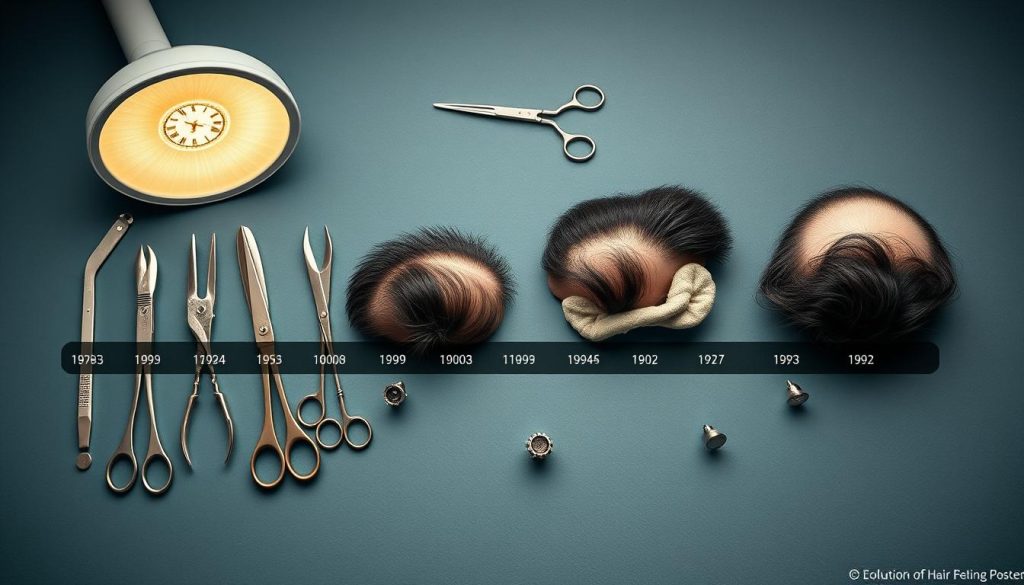
| Old Style Technique | Modern Adaptation | Impact on Current Practice |
|---|---|---|
| Punch Grafting | Follicular Unit Extraction (FUE) | A shift from noticeable plugs to seamless, natural results |
| Scalp Flaps | Advanced Flap Surgery | Enhanced control over hair direction and density |
| Scalp Reduction | Laser Therapy and Scalp Micropigmentation | Less invasive solutions with improved recovery times |
The move from old, noticeable methods to new, subtle ones is a big change. This change shows a major shift in how we deal with hair loss. It shows the hard work of doctors to make things better and more precise.
Today’s hair restoration is built on the lessons of the past. Each step has made the process safer, more effective, and better looking. So, the old ways have left us a valuable legacy. They help us see hair loss as a problem that can be fixed, with better results every day.
Preparing for a Hair Transplant: Tips and Essential Information
Starting your hair restoration journey needs careful planning for the best results. Before a hair transplant, it’s key to know the steps and if you’re a good candidate. This includes understanding preparing for hair transplant surgery and patient suitability assessment.
Evaluating Your Suitability for Hair Transplant Surgery
First, check if you’re eligible for hair restoration. A detailed check by a healthcare expert will tell if you’re a good match. They’ll look at your donor hair density, health, and why you’re losing hair.
Asking the Right Questions Before Your Procedure
The consultation is very important. You should have questions ready to learn about the surgery, recovery, and results. Ask about after-care, when hair will grow back, and how to get natural-looking results.
| Important Factor | Details to Consider |
|---|---|
| Patient Health | Make sure no health issues could affect the surgery’s success. |
| Donor Hair Quality | The quality and density of your donor hair affect the transplant’s success. |
| Expected Results | Know what results you can expect based on your hair loss and health. |
| Recovery Plan | Get clear on after-care to help your hair grow back well. |
Talking to your surgeon about these points helps in preparing for hair transplant surgery. It sets the right expectations and checks if you’re a good candidate. It’s important to understand and be confident in your decision, making sure it fits your health and beauty goals.
Setting Expectations: Realistic Outcomes of Traditional Hair Transplant Techniques
When it comes to hair restoration, it’s important to be both hopeful and realistic. Traditional hair transplant methods have helped many feel better about themselves. But, it’s key to know their limits.
These old methods have paved the way for today’s hair care. They can make hair look thicker, but might not meet today’s beauty standards. The results can vary, depending on the surgeon’s skill and the patient’s hair.
It’s vital for patients to talk openly with their doctors about what to expect. This talk should cover both the medical and emotional sides of hair transplant surgery. Knowing what’s possible helps patients feel more in control and ready for change.
FAQ
Q: What is considered old style hair transplant surgery?
A: Old style hair transplant surgery used outdated methods like punch grafts and mini/micrografting. These methods were invasive and left noticeable plugs or patches. This made the results look less natural than today’s techniques.
Q: How has hair transplant surgery evolved over time?
A: Hair transplant surgery has changed a lot over the years. It moved from old, invasive methods to new, advanced techniques like FUE and FUT. Now, we see more natural-looking results with less scarring and quicker recovery times.
Q: What distinguishes old style hair transplant techniques from modern procedures?
A: Old style techniques used larger grafts and left more visible scarring. Modern methods use smaller grafts for a natural look and less scarring. They also use advanced technology for better results and less discomfort.
Q: What are the typical procedures and methodologies of old style hair transplant surgery?
A: Old style hair transplant surgery included punch grafts, mini and micrografting, and scalp reduction. These methods involved removing and transplanting hair-bearing skin in patches.
Q: What is Follicular Unit Transplantation (FUT) and how does it work?
A: Follicular Unit Transplantation (FUT) removes a strip of hair-bearing skin from the scalp. It then transplants follicular units into balding areas. This method can leave a linear scar but allows for many grafts in one session.
Q: What were the typical outcomes and effectiveness of old style hair transplant surgery?
A: Old style hair transplant surgery results varied. Some patients got unnatural-looking results. The success depended on the surgeon’s skill and could involve scarring and less dense hair.
Q: What could a patient expect during old style hair transplant surgery and recovery?
A: Old style hair transplant surgery was invasive. Recovery was painful, with a high chance of visible scarring and a long healing time. This is much different from today’s methods.
Q: Why might someone choose an outdated hair transplant method?
A: Some choose old methods for cost reasons or lack of knowledge about new options. Others might prefer what they know or think is tried and true.
Q: How do old style hair replacement surgeries compare to modern alternatives?
A: Old style surgeries gave less natural results and longer recovery times. Modern methods like FUE and FUT offer better looks, less scarring, and faster recovery.
Q: What is the psychological impact of hair loss and how did surgical solutions like old style transplants promise to help?
A: Hair loss can greatly affect self-esteem and emotional well-being. Old style transplants aimed to restore hair and confidence, despite their aesthetic limitations.
Q: What other hair loss treatment options are available beyond old style transplants?
A: There are many non-surgical treatments now, like minoxidil, finasteride, and low-level laser therapy. These can be used alone or with surgery for better results.
Q: How do current hair restoration practices incorporate advancements from old style hair transplant techniques?
A: Modern practices use old techniques but with new technology and understanding. They offer better precision, aesthetics, and comfort, building on past successes.
Q: What should individuals consider when preparing for a hair transplant?
A: When preparing for a hair transplant, evaluate your suitability with a doctor. Understand the techniques, ask questions, and have realistic expectations about the results.
Q: What kind of results should patients realistically expect from traditional hair transplant techniques?
A: Patients should expect better hair density and coverage from traditional techniques. But, they should also be aware of possible scarring and less natural looks. Setting realistic goals is key for satisfaction.











